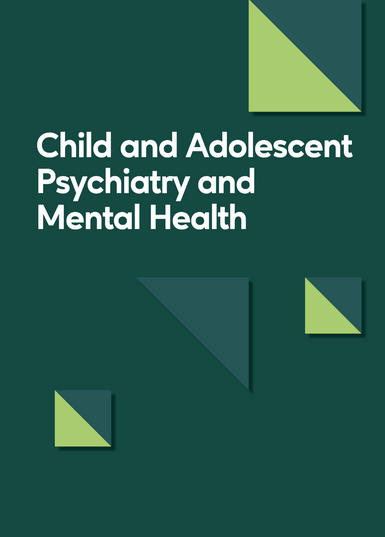Impact of the COVID-19 health crisis on psychotropic drug use in children and adolescents in France
IF 3.4
3区 医学
Q1 PEDIATRICS
Child and Adolescent Psychiatry and Mental Health
Pub Date : 2024-09-16
DOI:10.1186/s13034-024-00806-z
引用次数: 0
Abstract
In 2019, the world faced a pandemic brought about by a severe acute respiratory infection caused by SARS-CoV-2 virus. The spread of this virus has profoundly affected societies, particularly in terms of their economic, human and social dimensions, as well as their healthcare systems. Several restrictive measures (reduced social interaction, periodic school closures,…) had to be taken to contain the spread of the virus. These measures have had an impact on the psychological well-being of both adults and children. The aim of this study was to assess the changes in psychotropic drugs prescriptions for children and adolescents living in Limousin, a French region, over the period 2018 to 2021. The consumption of psychotropic drugs was studied using a national database of drug reimbursement. These data were extracted and supplied from the nationwide French reimbursement healthcare system database (SNDS). The following therapeutic classes were studied: N05A (antipsychotics), N05B (anxiolytics), N05C (hypnotics and sedatives), N06A (antidepressants) and N06B (psychostimulants). Data were collected for insured persons under the age of 18 who received at least one reimbursement for a psychotropic drug between 2018 and 2021. Over a 4-year period, 7949 patients under the age of 18 were included with an average age of 12.1 years and a sex ratio of 0.97 M/F. The number of patients increased from 2018 to 2021, as did the number of reimbursements. We observed a statistically significant difference of means of patients reimbursed per week for on five therapeutic classes, with the greatest difference in 2021 (p < 0.0001). An increase in the number of patients of between + 20.7% and + 689% was observed, depending on the drug classes studied. Comparisons between the COVID-19 and pre-COVID-19 periods showed a significantly higher COVID average for psychotropic drugs reimbursements in general and individually for all classes except psychostimulants. The results show a significant increase in the consumption of psychotropic drugs among youth. The increase in psychotropic drug use was continuous and progressive throughout the pandemic. All five classes were increased, but particularly anxiolytics and antidepressants. The COVID-19 context may have been at the origin of a deterioration in the mental health of children and adolescents, or of a heightened awareness of psychiatric care among young people.COVID-19 健康危机对法国儿童和青少年使用精神药物的影响
2019 年,世界面临着一场由 SARS-CoV-2 病毒引起的严重急性呼吸道感染造成的大流行。这种病毒的传播对社会产生了深远的影响,尤其是在经济、人文和社会层面,以及医疗保健系统方面。不得不采取一些限制性措施(减少社会交往、定期关闭学校......)来遏制病毒的传播。这些措施对成人和儿童的心理健康都产生了影响。本研究旨在评估 2018 年至 2021 年期间法国利穆赞大区儿童和青少年精神药物处方的变化情况。研究使用全国药品报销数据库对精神药物的消费情况进行了调查。这些数据是从法国全国报销医疗系统数据库(SNDS)中提取和提供的。研究涉及以下治疗类别:N05A(抗精神病药)、N05B(抗焦虑药)、N05C(催眠药和镇静剂)、N06A(抗抑郁药)和 N06B(精神兴奋剂)。数据收集对象为 2018 年至 2021 年期间至少获得过一次精神药物报销的 18 岁以下被保险人。4 年间,共纳入 7949 名 18 岁以下患者,平均年龄为 12.1 岁,男女性别比为 0.97。从 2018 年到 2021 年,患者人数有所增加,报销人数也有所增加。我们观察到,在五种治疗类别中,每周报销的患者平均人数差异具有统计学意义,其中 2021 年的差异最大(p < 0.0001)。根据所研究的药物类别,患者人数增加了 + 20.7% 到 + 689%。COVID-19 与 COVID-19 前的比较显示,除精神刺激剂外,COVID 对精神药物的总体和单个类别的平均报销额都显著增加。结果显示,青少年的精神药物消费量大幅增加。在整个大流行期间,精神药物使用量的增长是持续和渐进的。所有五类药物的使用量都有所增加,尤其是抗焦虑药和抗抑郁药。COVID-19 的背景可能是儿童和青少年心理健康状况恶化的根源,也可能是青少年对精神病护理认识提高的根源。
本文章由计算机程序翻译,如有差异,请以英文原文为准。
求助全文
约1分钟内获得全文
求助全文
来源期刊

Child and Adolescent Psychiatry and Mental Health
PEDIATRICSPSYCHIATRY-PSYCHIATRY
CiteScore
7.00
自引率
3.60%
发文量
84
审稿时长
16 weeks
期刊介绍:
Child and Adolescent Psychiatry and Mental Health, the official journal of the International Association for Child and Adolescent Psychiatry and Allied Professions, is an open access, online journal that provides an international platform for rapid and comprehensive scientific communication on child and adolescent mental health across different cultural backgrounds. CAPMH serves as a scientifically rigorous and broadly open forum for both interdisciplinary and cross-cultural exchange of research information, involving psychiatrists, paediatricians, psychologists, neuroscientists, and allied disciplines. The journal focusses on improving the knowledge base for the diagnosis, prognosis and treatment of mental health conditions in children and adolescents, and aims to integrate basic science, clinical research and the practical implementation of research findings. In addition, aspects which are still underrepresented in the traditional journals such as neurobiology and neuropsychology of psychiatric disorders in childhood and adolescence are considered.
 求助内容:
求助内容: 应助结果提醒方式:
应助结果提醒方式:


